warning light CADILLAC CTS 2008 2.G Owner's Guide
[x] Cancel search | Manufacturer: CADILLAC, Model Year: 2008, Model line: CTS, Model: CADILLAC CTS 2008 2.GPages: 490, PDF Size: 2.59 MB
Page 276 of 490

StabiliTrak®System
The vehicle has an electronic stability control system
called StabiliTrak. It is an advanced computer controlled
system that assists with directional control of the
vehicle in difficult driving conditions.
StabiliTrak activates when the computer senses a
discrepancy between your intended path and the
direction the vehicle is actually traveling. StabiliTrak
selectively applies braking pressure at any one of the
vehicle’s brakes to help steer the vehicle in the direction
which you are steering.
When the system activates, the Traction Control System
(TCS)/StabiliTrak warning light on the instrument
panel cluster �ashes. You may also hear a noise or feel
vibration in the brake pedal. This is normal. Continue
to steer the vehicle in the direction you want it to go.
If there is a problem detected with StabiliTrak, a Service
Stability System message displays on the Driver
Information Center (DIC) and the TCS/StabiliTrakwarning light on the instrument panel cluster comes on.
When this message and warning light displays, the
system is not operational. Driving should be adjusted
accordingly. SeeDIC Warnings and Messages on
page 3-56andWarning Lights, Gages, and Indicators
on page 3-30for more information.
StabiliTrak comes on automatically whenever the vehicle
is started. The system should be left on to help assist with
directional control of the vehicle. If StabiliTrak needs to
be turned off, press the TC (traction control) on/off button.
SeeTraction Control System (TCS) on page 4-6.
If cruise control is being used when the StabiliTrak
activates, the cruise control will automatically disengage.
When road conditions allow, reengage the cruise
control. SeeCruise Control on page 3-14for more
information.
4-8
Page 277 of 490

Panic Brake Assist
Your vehicle has a panic brake assist system that
monitors the intention of the driver while braking. If the
system senses that the driver has applied hard/fast
pressure to the brake pedal, the system will generate
additional pressure, making it easier for the driver to
maintain brake application. When this happens the brake
pedal will feel easier to push. Just hold the brake pedal
down �rmly and let the system work for you. You may feel
the brakes vibrate, or you may notice some noise but this
is normal. The brakes will return to normal operation after
the brake pedal has been released.
All-Wheel Drive (AWD) System
If your vehicle has this feature, the AWD system will
automatically monitor and adjust engine power to
the front and rear wheels for the best traction and
handling. If there is a loss of traction or stability,
the AWD system works with the Electronic Stability
Control (ESC) system to increase power to the
front wheels as necessary.
If the spare tire is on the vehicle, there may be a slight
reduction in performance of the AWD system.
SeeDIC Warnings and Messages on page 3-56for
AWD related DIC messages.
Steering
Power Steering
If you lose power steering assist because the engine
stops or the system is not functioning, you can steer but
it will take much more effort.
Speed Variable Assist Steering
Your vehicle has a steering system that varies the
amount of effort required to steer the vehicle in relation
to the speed of the vehicle.
The amount of steering effort required is less at slower
speeds to make the vehicle more maneuverable
and easier to park. At faster speeds, the steering effort
increases to provide a sport-like feel to the steering.
This provides maximum control and stability.
If your vehicle seems harder to steer than normal when
parking or driving slowly, there may be a problem
with the system. You will still have power steering, but
steering will be stiffer than normal at slow speeds.
See your dealer/retailer for service.
4-9
Page 283 of 490
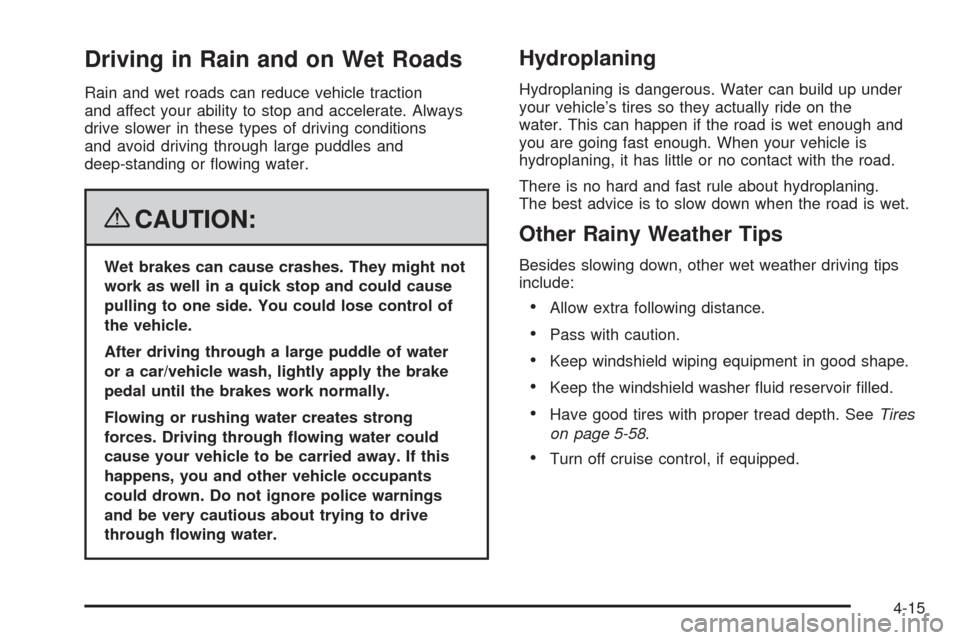
Driving in Rain and on Wet Roads
Rain and wet roads can reduce vehicle traction
and affect your ability to stop and accelerate. Always
drive slower in these types of driving conditions
and avoid driving through large puddles and
deep-standing or �owing water.
{CAUTION:
Wet brakes can cause crashes. They might not
work as well in a quick stop and could cause
pulling to one side. You could lose control of
the vehicle.
After driving through a large puddle of water
or a car/vehicle wash, lightly apply the brake
pedal until the brakes work normally.
Flowing or rushing water creates strong
forces. Driving through �owing water could
cause your vehicle to be carried away. If this
happens, you and other vehicle occupants
could drown. Do not ignore police warnings
and be very cautious about trying to drive
through �owing water.
Hydroplaning
Hydroplaning is dangerous. Water can build up under
your vehicle’s tires so they actually ride on the
water. This can happen if the road is wet enough and
you are going fast enough. When your vehicle is
hydroplaning, it has little or no contact with the road.
There is no hard and fast rule about hydroplaning.
The best advice is to slow down when the road is wet.
Other Rainy Weather Tips
Besides slowing down, other wet weather driving tips
include:
Allow extra following distance.
Pass with caution.
Keep windshield wiping equipment in good shape.
Keep the windshield washer �uid reservoir �lled.
Have good tires with proper tread depth. SeeTires
on page 5-58.
Turn off cruise control, if equipped.
4-15
Page 285 of 490
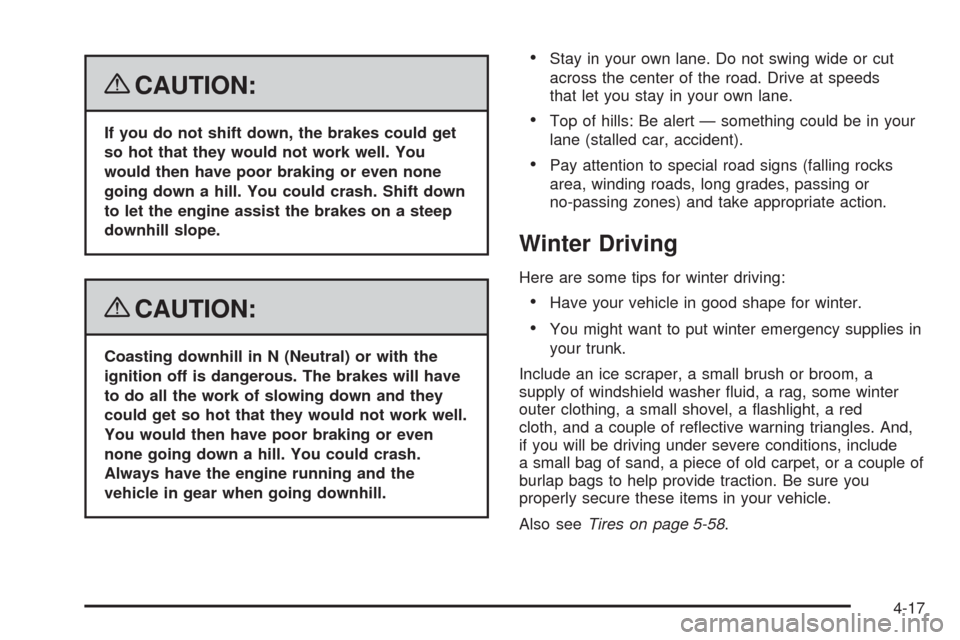
{CAUTION:
If you do not shift down, the brakes could get
so hot that they would not work well. You
would then have poor braking or even none
going down a hill. You could crash. Shift down
to let the engine assist the brakes on a steep
downhill slope.
{CAUTION:
Coasting downhill in N (Neutral) or with the
ignition off is dangerous. The brakes will have
to do all the work of slowing down and they
could get so hot that they would not work well.
You would then have poor braking or even
none going down a hill. You could crash.
Always have the engine running and the
vehicle in gear when going downhill.
Stay in your own lane. Do not swing wide or cut
across the center of the road. Drive at speeds
that let you stay in your own lane.
Top of hills: Be alert — something could be in your
lane (stalled car, accident).
Pay attention to special road signs (falling rocks
area, winding roads, long grades, passing or
no-passing zones) and take appropriate action.
Winter Driving
Here are some tips for winter driving:
Have your vehicle in good shape for winter.
You might want to put winter emergency supplies in
your trunk.
Include an ice scraper, a small brush or broom, a
supply of windshield washer �uid, a rag, some winter
outer clothing, a small shovel, a �ashlight, a red
cloth, and a couple of re�ective warning triangles. And,
if you will be driving under severe conditions, include
a small bag of sand, a piece of old carpet, or a couple of
burlap bags to help provide traction. Be sure you
properly secure these items in your vehicle.
Also seeTires on page 5-58.
4-17
Page 304 of 490
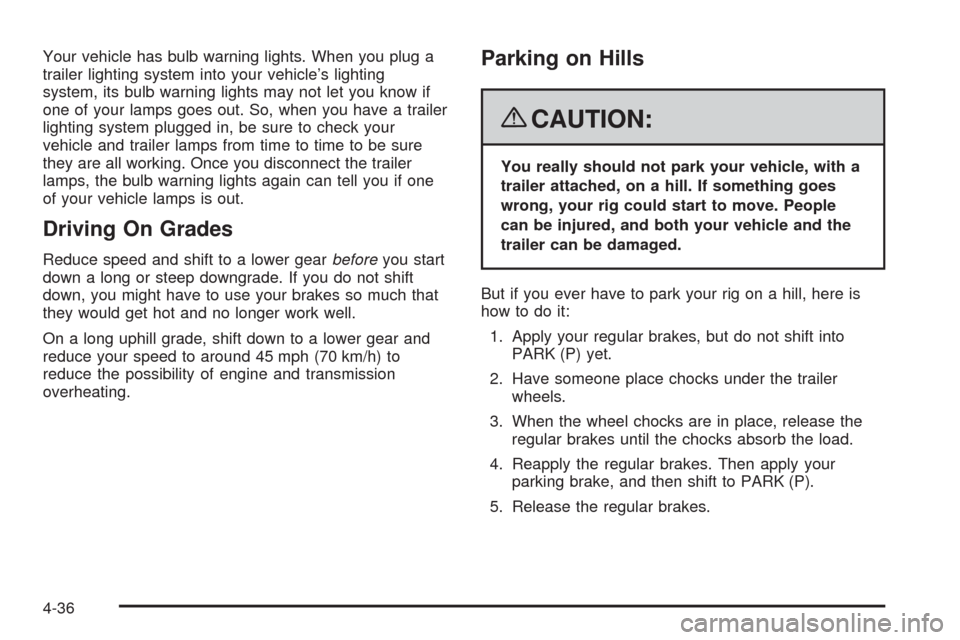
Your vehicle has bulb warning lights. When you plug a
trailer lighting system into your vehicle’s lighting
system, its bulb warning lights may not let you know if
one of your lamps goes out. So, when you have a trailer
lighting system plugged in, be sure to check your
vehicle and trailer lamps from time to time to be sure
they are all working. Once you disconnect the trailer
lamps, the bulb warning lights again can tell you if one
of your vehicle lamps is out.
Driving On Grades
Reduce speed and shift to a lower gearbeforeyou start
down a long or steep downgrade. If you do not shift
down, you might have to use your brakes so much that
they would get hot and no longer work well.
On a long uphill grade, shift down to a lower gear and
reduce your speed to around 45 mph (70 km/h) to
reduce the possibility of engine and transmission
overheating.
Parking on Hills
{CAUTION:
You really should not park your vehicle, with a
trailer attached, on a hill. If something goes
wrong, your rig could start to move. People
can be injured, and both your vehicle and the
trailer can be damaged.
But if you ever have to park your rig on a hill, here is
how to do it:
1. Apply your regular brakes, but do not shift into
PARK (P) yet.
2. Have someone place chocks under the trailer
wheels.
3. When the wheel chocks are in place, release the
regular brakes until the chocks absorb the load.
4. Reapply the regular brakes. Then apply your
parking brake, and then shift to PARK (P).
5. Release the regular brakes.
4-36
Page 307 of 490
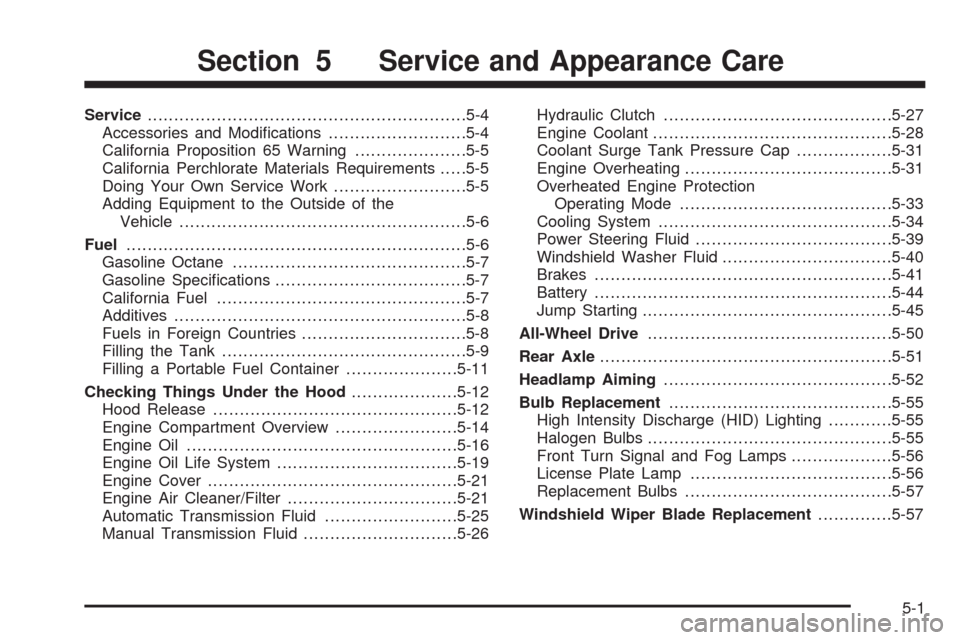
Service............................................................5-4
Accessories and Modi�cations..........................5-4
California Proposition 65 Warning.....................5-5
California Perchlorate Materials Requirements.....5-5
Doing Your Own Service Work.........................5-5
Adding Equipment to the Outside of the
Vehicle......................................................5-6
Fuel................................................................5-6
Gasoline Octane............................................5-7
Gasoline Speci�cations....................................5-7
California Fuel...............................................5-7
Additives.......................................................5-8
Fuels in Foreign Countries...............................5-8
Filling the Tank..............................................5-9
Filling a Portable Fuel Container.....................5-11
Checking Things Under the Hood....................5-12
Hood Release..............................................5-12
Engine Compartment Overview.......................5-14
Engine Oil...................................................5-16
Engine Oil Life System..................................5-19
Engine Cover...............................................5-21
Engine Air Cleaner/Filter................................5-21
Automatic Transmission Fluid.........................5-25
Manual Transmission Fluid.............................5-26Hydraulic Clutch...........................................5-27
Engine Coolant.............................................5-28
Coolant Surge Tank Pressure Cap..................5-31
Engine Overheating.......................................5-31
Overheated Engine Protection
Operating Mode........................................5-33
Cooling System............................................5-34
Power Steering Fluid.....................................5-39
Windshield Washer Fluid................................5-40
Brakes........................................................5-41
Battery........................................................5-44
Jump Starting...............................................5-45
All-Wheel Drive..............................................5-50
Rear Axle.......................................................5-51
Headlamp Aiming...........................................5-52
Bulb Replacement..........................................5-55
High Intensity Discharge (HID) Lighting............5-55
Halogen Bulbs..............................................5-55
Front Turn Signal and Fog Lamps...................5-56
License Plate Lamp......................................5-56
Replacement Bulbs.......................................5-57
Windshield Wiper Blade Replacement..............5-57
Section 5 Service and Appearance Care
5-1
Page 317 of 490
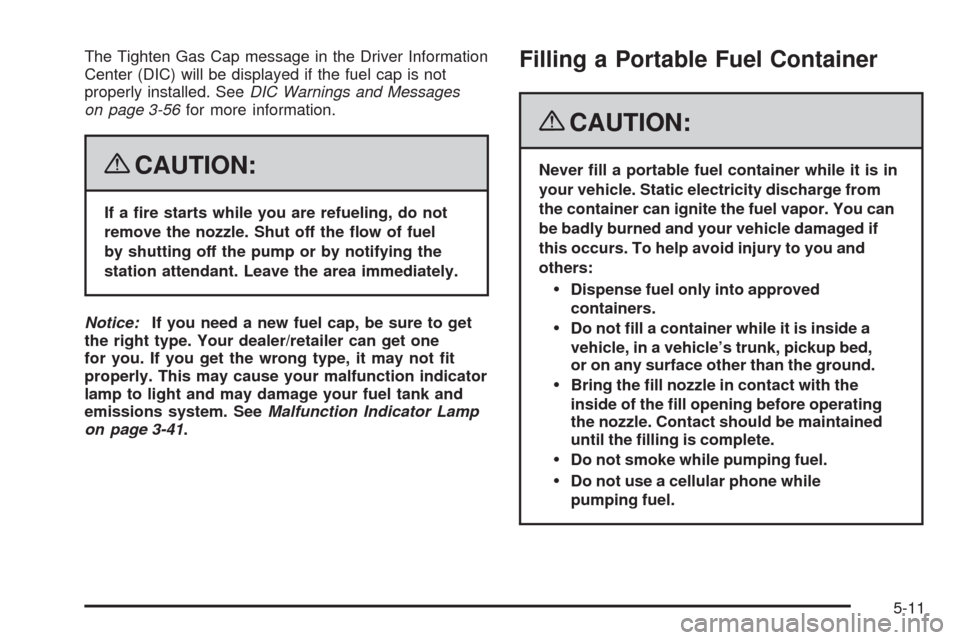
The Tighten Gas Cap message in the Driver Information
Center (DIC) will be displayed if the fuel cap is not
properly installed. SeeDIC Warnings and Messages
on page 3-56for more information.
{CAUTION:
If a �re starts while you are refueling, do not
remove the nozzle. Shut off the �ow of fuel
by shutting off the pump or by notifying the
station attendant. Leave the area immediately.
Notice:If you need a new fuel cap, be sure to get
the right type. Your dealer/retailer can get one
for you. If you get the wrong type, it may not �t
properly. This may cause your malfunction indicator
lamp to light and may damage your fuel tank and
emissions system. SeeMalfunction Indicator Lamp
on page 3-41.
Filling a Portable Fuel Container
{CAUTION:
Never �ll a portable fuel container while it is in
your vehicle. Static electricity discharge from
the container can ignite the fuel vapor. You can
be badly burned and your vehicle damaged if
this occurs. To help avoid injury to you and
others:
Dispense fuel only into approved
containers.
Do not �ll a container while it is inside a
vehicle, in a vehicle’s trunk, pickup bed,
or on any surface other than the ground.
Bring the �ll nozzle in contact with the
inside of the �ll opening before operating
the nozzle. Contact should be maintained
until the �lling is complete.
Do not smoke while pumping fuel.
Do not use a cellular phone while
pumping fuel.
5-11
Page 322 of 490
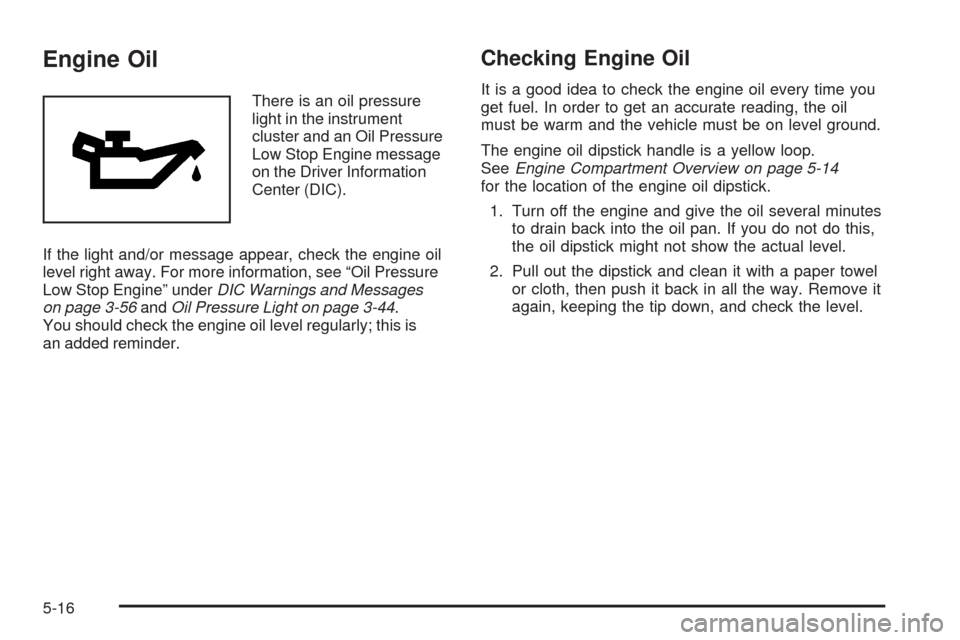
Engine Oil
There is an oil pressure
light in the instrument
cluster and an Oil Pressure
Low Stop Engine message
on the Driver Information
Center (DIC).
If the light and/or message appear, check the engine oil
level right away. For more information, see “Oil Pressure
Low Stop Engine” underDIC Warnings and Messages
on page 3-56andOil Pressure Light on page 3-44.
You should check the engine oil level regularly; this is
an added reminder.
Checking Engine Oil
It is a good idea to check the engine oil every time you
get fuel. In order to get an accurate reading, the oil
must be warm and the vehicle must be on level ground.
The engine oil dipstick handle is a yellow loop.
SeeEngine Compartment Overview on page 5-14
for the location of the engine oil dipstick.
1. Turn off the engine and give the oil several minutes
to drain back into the oil pan. If you do not do this,
the oil dipstick might not show the actual level.
2. Pull out the dipstick and clean it with a paper towel
or cloth, then push it back in all the way. Remove it
again, keeping the tip down, and check the level.
5-16
Page 334 of 490

How to Check and Add Fluid
Visually check the clutch �uid reservoir to make sure the
�uid level is at the MIN (Minimum) line on the side of the
reservoir. The hydraulic clutch �uid system should be
kept closed and sealed. Do not remove the cap to check
the �uid level or to top-off the �uid level. Remove the cap
only when necessary to add the proper �uid until the level
reaches the MIN line.
Engine Coolant
The cooling system in your vehicle is �lled with
DEX-COOL®engine coolant. This coolant is designed
to remain in your vehicle for �ve years or 150,000 miles
(240 000 km), whichever occurs �rst, if you add only
DEX-COOL
®extended life coolant.
The following explains the cooling system and how to
add coolant when it is low. If the engine overheats, see
Engine Overheating on page 5-31.A 50/50 mixture of clean, drinkable water and
DEX-COOL
®coolant will:
Give freezing protection down to−34°F (−37°C).
Give boiling protection up to 265°F (129°C).
Protect against rust and corrosion.
Help keep the proper engine temperature.
Allow the warning lights and gages to work as they
should.
Notice:Using coolant other than DEX-COOL
®can
cause premature engine, heater core, or radiator
corrosion. In addition, the engine coolant may
require changing sooner, at the �rst maintenance
service after each 30,000 miles (50 000 km) or
24 months, whichever occurs �rst. Any repairs would
not be covered by the vehicle warranty. Always use
DEX-COOL
®(silicate-free) coolant in the vehicle.
5-28
Page 347 of 490

Brakes
Brake Fluid
The brake master cylinder
reservoir is �lled with
DOT-3 brake �uid. See
Engine Compartment
Overview on page 5-14for
the location of the reservoir.
There are only two reasons why the brake �uid level in
the reservoir might go down. The �rst is that the brake
�uid goes down to an acceptable level during normal
brake lining wear. When new linings are put in, the �uid
level goes back up. The other reason is that �uid is
leaking out of the brake hydraulic system. If it is, have
the brake hydraulic system �xed, since a leak means
that sooner or later the brakes will not work well.Do not top off the brake �uid. Adding brake �uid will not
correct a leak. If �uid is added when the linings are
worn, there will be too much �uid when new brake
linings are installed. Add or remove brake �uid, as
necessary, only when work is done on the brake
hydraulic system.
{CAUTION:
If your vehicle has too much brake �uid, it can
spill on the engine. The �uid will burn if the
engine is hot enough. You or others could be
burned, and your vehicle could be damaged.
Add brake �uid only when work is done on
the brake hydraulic system.
If the ignition is in ON/RUN and the brake �uid is low,
the Service Brake System message will be displayed in
the DIC. SeeDIC Warnings and Messages on page 3-56.
When the brake �uid falls to a low level, the brake
warning light will come on. SeeBrake System Warning
Light on page 3-38.
5-41